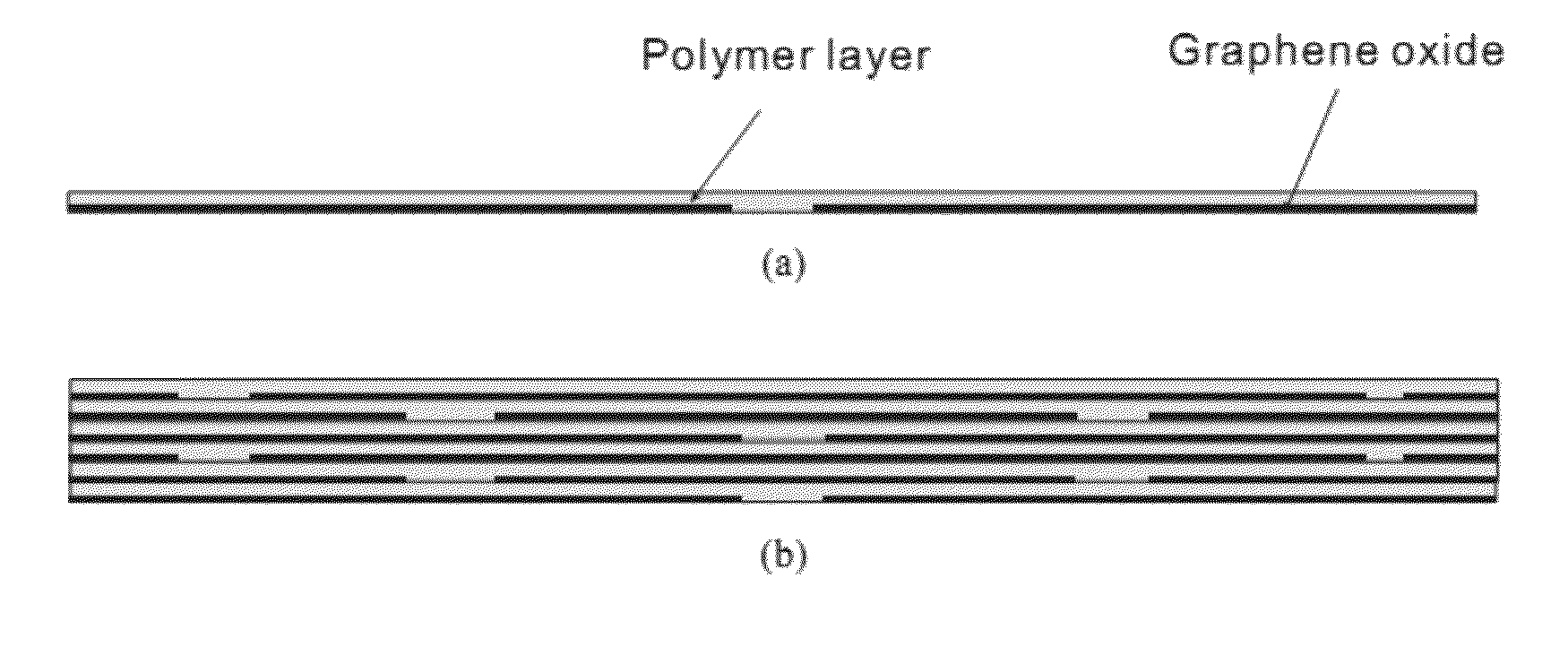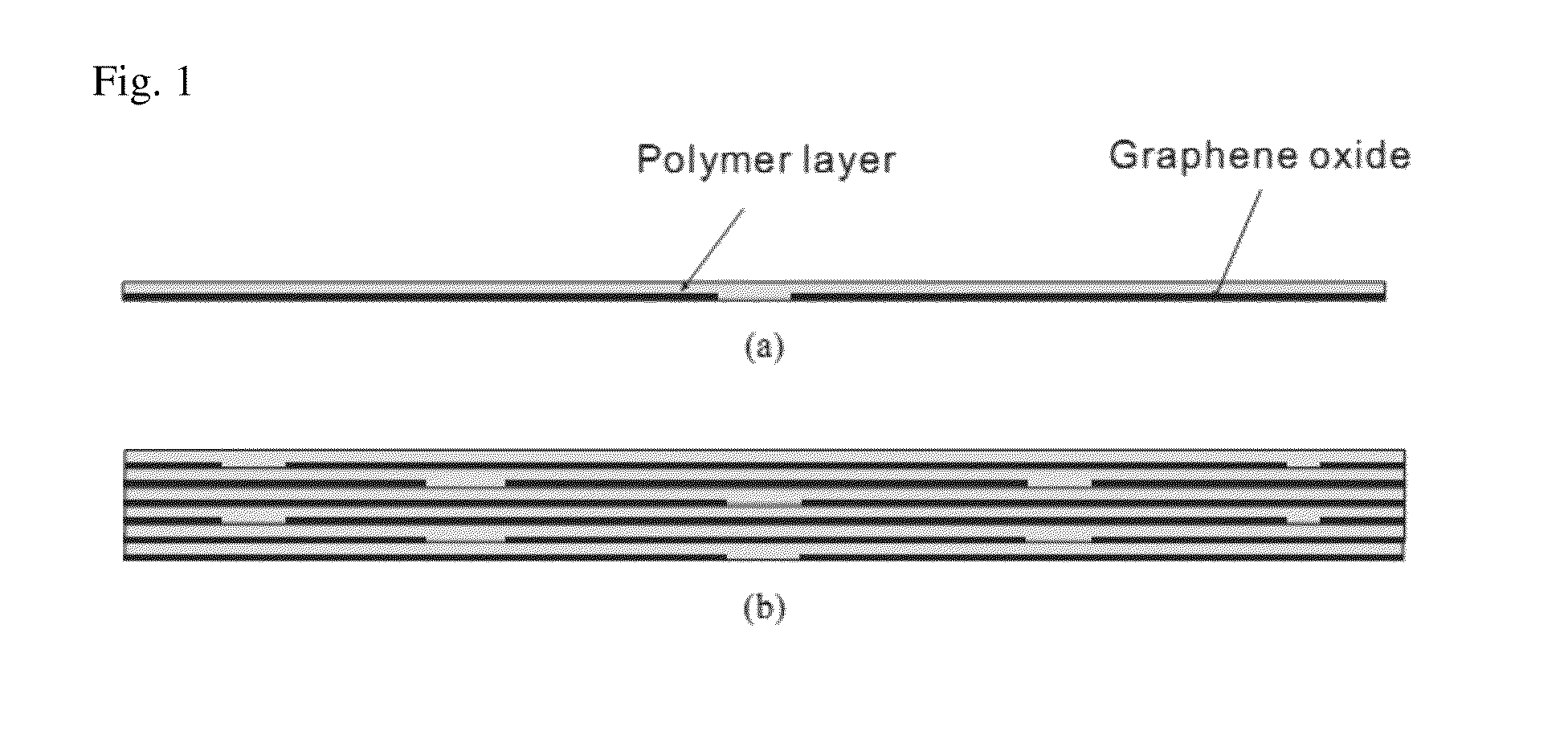Encapsulation film with thin layer composed of graphene oxide and reduced graphene oxide and method for forming the same
a technology of graphene oxide and encapsulation film, which is applied in the field of encapsulation film, can solve the problems of low fraction load resistance of graphene, limited application method to a device requiring a large area, and low cost encapsulation process, so as to reduce the raw material cost of the device, reduce the manufacturing cost, and maximize the thickness of the organic polymer layer
- Summary
- Abstract
- Description
- Claims
- Application Information
AI Technical Summary
Benefits of technology
Problems solved by technology
Method used
Image
Examples
first experimental example
[0095]A bilayer is formed on a PET substrate by the electrostatic attraction between a thin layer composed of graphene oxide manufactured by a Hummer process and an organic material composed of PDDA polymer according to a scheme illustrated in FIG. 2, and the thin layer is illustrated in FIG. 5 when observed through a SEM.
[0096]As illustrated in FIG. 5, when the bilayer is formed by the electrostatic attraction between a thin layer composed of graphene oxide and an organic polymer layer composed of PDDA polymer, it may be confirmed that a thin layer composed of graphene oxide covers at least 90% of a surface of a PET substrate so that the encapsulation film may represent a necessary blocking property.
second experimental example
[0097]A bilayer according to the first experimental example is laminated to a three layer structure so that a multi-layer encapsulation film is manufactured. A Ca thin film deposited on a glass substrate is covered with a PET substrate coated with the multi-layer encapsulation film. Variation in an electric conductivity of a Ca thin film is measured by exposing a sample to 40° C. 80% RH atmosphere and the measured variation in the electric conductivity of a Ca thin film is illustrated in FIG. 6. Further, for the comparison, after a Ca thin film coated on a glass substrate is encapsulated by a PET substrate which is not coated with the bilayer, variation in the electric conductivity of the Ca thin film is measured and illustrated in the graph of FIG. 6.
[0098]Referring to FIG. 6, when the PET substrate which is not coated with the bilayer is used, the electric conductivity of the Ca thin film is rapidly reduced according to an exposure time. In contrast, when the PET substrate coated ...
third experimental example
[0099]In order to confirm formation of the thin layer composed of the graphene oxide or the reduced graphene oxide using the suspension casting process, a thin layer of 0.05 g / mole composed of the graphene oxide dispersed in the suspension as a porous base reacts with the suspension to form hydrates so that the hydrates are used as a plaster of Paris. External artificial pressure is not applied, and the suspension in which a thin layer composed of graphene oxide is dispersed is injected into a plaster base of Paris for minute. An SEM photograph of the plaster base of Paris before the suspension is injected is illustrated in FIG. 7(a), and an SEM photograph of the plaster base of Paris with the thin layer after the suspension is injected is illustrated in FIG. 7(b).
[0100]Referring to FIG. 7, when the thin layer is formed by the suspension casting process using the plaster of Paris, it may be confirmed that a significantly sensed thin layer is formed without the opening between thin l...
PUM
| Property | Measurement | Unit |
|---|---|---|
| Thickness | aaaaa | aaaaa |
| Thickness | aaaaa | aaaaa |
| Diameter | aaaaa | aaaaa |
Abstract
Description
Claims
Application Information
 Login to View More
Login to View More - R&D
- Intellectual Property
- Life Sciences
- Materials
- Tech Scout
- Unparalleled Data Quality
- Higher Quality Content
- 60% Fewer Hallucinations
Browse by: Latest US Patents, China's latest patents, Technical Efficacy Thesaurus, Application Domain, Technology Topic, Popular Technical Reports.
© 2025 PatSnap. All rights reserved.Legal|Privacy policy|Modern Slavery Act Transparency Statement|Sitemap|About US| Contact US: help@patsnap.com



